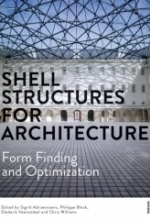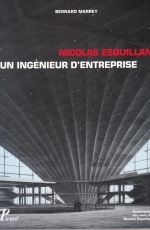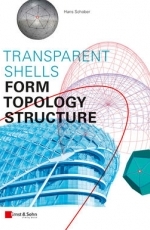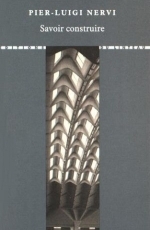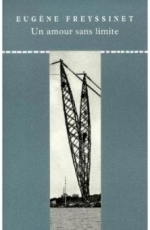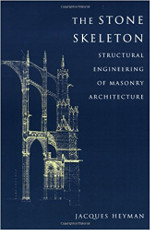Journal articles
- All
- Architectural Geometry
- Gridshell
- Nexorade
- Steel Structures
- Concrete printing
- Active Bending
- Deployable structures
- Composite Material
- Environmental Design
The Caravel heX-Mesh pavilion, illustration of a new strategy for gridshell rationalization – Tellier et al. (2019)
Authors
X Tellier, S. Zerhouni, G. Jami, A. Le Pavec, T. Lenart, M. Lerouge, N. Leduc, C. Douthe, L. Hauswirth, O. Baverel
Abstract
The fabrication of a freeform structural envelope is usually a highly complex task. The costliest aspect is often the connections between the constitutive parts. The Caravel heX-Mesh Pavilion is a prototype that demonstrates a new rationalization strategy. Its structure, composed of a hexagonal grid of beams and cladding panels, is based on a geometry that rationalizes connections at two levels: firstly, nodes are free of geometrical torsion and are repetitive: only two types of nodes are used. Secondly, panels can easily be connected to the support beams as they are orthogonal to each other. The mechanical behavior is validated by finite-element analysis. We generate these meshes by numerical optimization from a smooth target surface, with an initialization derived from the asymptotic case and surface theory. The pavilion shows an alternative way of rationalizing a gridshell beyond the popular planar-quad meshes and circular/conical meshes. It also demonstrates a way to generate hexagonal gridshells which are not necessarily synclastic, this limitation being typically imposed to achieve planarity of cladding panels.
Surfaces with planar curvature lines: Discretization, generation and application to the rationalization of curved architectural envelopes – X. Tellier et al. (2019)
Author
Xavier Tellier, Cyril Douthe, Laurent Hauswirth, Olivier Baverel
Abstract
Motivated by architectural applications, we propose a method to generate circular and conical meshes with planar curvature lines in both directions. The method is based on the discretization of the Gauss map of surfaces with planar curvatures lines. It allows generation of meshes in real-time via two planar guide curves. The resulting meshes can be used as a geometric base to build gridshells with flat panels, torsion free-nodes, node offset and planar arches. A particular technological application is for gridshells built with curved members: those can be built with planar piecewise-circular beams, and identical nodes if beams have circular cross-section.
Linear Weingarten surfaces for conceptual design – X. Tellier et al. (2019)
Author
Xavier Tellier, Cyril Douthe, Olivier Baverel, Laurent Hauswirth
Abstract
Designing freeform architectural envelopes is a challenging task, as it requires a balance between structural efficiency, fabricability and architectural requirements. In this article, we present a novel numerical form-finding method based on the generation of the so-called Linear Weingarten surfaces. The method allows to build these surfaces on a target boundary curve. Surfaces are calculated by minimizing of a new functional. The method is well suited for conceptual design, as it generates shapes at membrane equilibrium under uniform pressure load, and gives a direct feedback on internal stresses. One notable application is for the design of steel-glass gridshells, for which mechanical performance and ease of fabrication can be combined.
Status
Published
Journal
Proceedings of the fib Conceptual Design Symposium, Madrid 2019
Links
Discrete CMC surfaces for doubly-curved building envelopes – X. Tellier et al. (2018)
Author
Xavier Tellier, Cyril Douthe, Olivier Baverel, Laurent Hauswirth
Abstract
Constant mean curvature surfaces (CMCs) have many interesting properties for use as a form for doubly curved structural envelopes. The discretization of these surfaces has been a focus of research amongst the discrete differential geometry community. Many of the proposed discretizations have remarkable properties for envelope rationalization purposes. However, little attention has been paid to generation methods intended for designers.
This paper proposes an extension to CMCs of the method developed by Bobenko, Hoffmann and Springborn (2006) to generate minimal S-isothermic nets. The method takes as input a CMC (smooth or finely triangulated), remeshes its Gauss map with quadrangular faces, and rebuilds a CMC mesh via a parallel transformation. The resulting mesh is S-CMC, a geometric structure discovered by Hoffmann (2010). This type of mesh have planar quads and offset properties, which are of particular interest in the fabrication of gridshells.
A study on the effects of an explosion in the Pantheon of Rome
Author
Filippo Masi, Ioannis Stefanou, Paolo Vannucci
Abstract
The response of an emblematic monumental structure, the Pantheon in Rome, to an internal blast is addressed. The analysis is a coupled solid-fluid numerical simulation done using JWL equation for the simulation of the blast event and considering the pre-existent cracks in the dome as well as the material nonlinearities of low-tensile strength concrete aggregates. We identify two main phenomena; a focalization of shock waves inside dome-vaulted like structures due to their tendency to concentrate the blast energy and the role played by the pre-existent cracks in the evolution of the structural damage.
Fabrication-aware shape parametrisation for the structural optimisation of shell structures – R. Mesnil et al. (2018)
Author
R. Mesnil, C. Douthe, C. Richter, O. Baverel
Abstract
The difficulty to construct mechanically optimal shells may limit the use of structural optimisation in practice. The objective of this paper is to propose a new parametric representation of doubly curved shapes suited for structural optimisation of architectural shells that inherently considers fabrication constraints. We focus on a common construction constraint: the covering of building envelopes with planar facets. This paper proposes to implement the so-called marionette technique as a Computer-Aided-Design tool that guarantees covering of free-form shapes with planar quadrilateral facets.
General considerations on the size and nature of the optimisation space created with this method are made. It is demonstrated through different case-studies that the quality of the parametrisation for shape optimisation of shell structures is similar to the one offered by NURBS, an ubiquitous modelling technique. The proposed method conciliates thus fabrication and structural performance.
A re-parameterization approach for the construction of domes with planar facets – R. Mesnil (2018)
Author
R. Mesnil
Abstract
The aim of this article is to propose parameterization with planar facets of dome structures. The technique
introduced in this paper starts from an input parameterization and creates a dual pattern with planar quadrilateral facets. The derivation of the analytical solution allows to link the method with the creation of meshes with planar hexagonal facets and of circle packing on spheres. The method can be used in various contexts and allows designers to design with two superimposed parameterizations, which allows for a potential decoupling between structure and envelope.
Morphogenesis of surfaces with planar lines of curvature and applications to architectural design – R. Mesnil et al. (2018)
Authors
R. Mesnil, C. Douthe, O. Baverel, B. Léger
Abstract
This article presents a methodology to generate surfaces with planar lines of curvature from two or three curves and tailored for architectural design. Meshing with planar quadrilateral facets and optimal offset properties for the structural layout are guaranteed. The methodology relies on the invariance of circular meshes by spherical inversion and discrete Combescure transformations, and uses parametrisation of surfaces with cyclidic patches. The shapes resulting from our methodology are called super-canal surfaces by the authors, as they are an extension of canal surfaces. An interesting connection to shell theory is recalled, as the shapes proposed in this paper are at equilibrium under uniform normal loading. Some applications of these shapes to architecture are shown.
Form finding of reciprocal frames using the translations method – R. Mesnil et al. (2018)
Authors
R. Mesnil, C. Douthe, O. Baverel, T. Gobin
Abstract
This article proposes a new computational method for the form-finding of nexorades, also called reciprocal frames by some authors. The method is based on the translations of the members forming the initial layout. It is shown that the two geometrical quantities defining nexorades - eccentricity and engagement length - depend linearly on the transformation parameters. The method is thus based on linear algebra, so that fitting problems can be formulated as quadratic optimisation problems under linear constraints. The proposed method is therefore fast, simple to implement, robust and can be applied to various grid patterns.
Furthemore, the proposed framework preserves planar facets. This paper proposes thus a new structural system where the nexorade is braced by planar facets. The feasibility of this structural system and of the computational framework introduced in this article is demonstrated by the fabrication of a 50m² timber pavilion.
Feature-based Topology Finding of Patterns for Shell Structures – R. Oval et al. (2019)
Authors
R. Oval, M. Rippmann, R. Mesnil, T. Van Mele, O. Baverel, P. Block
Abstract
This paper introduces topology finding of patterns such as beam grids for gridshells or voussoir tessellations for masonry vaults, among others. The authors refer to topology finding, by analogy and in complement to form finding, as the design of the connectivity of patterns in order to follow architectural, structural and construction requirements. This paper presents an automated generation and a rule-based exploration for coarse quad meshes that encode the data about the singularities and their relationships in the pattern. The automated generation relies on the medial axis of an input shape, and the rule-based exploration on a quad mesh grammar. These coarse quad meshes are further computed for the design of structured patterns integrating the boundary and features of the input shape. This design framework is an aid for topological exploration of patterns for shell-like structures by architects and engineers.
Non-standard patterns for gridshell structures: Fabrication and Structural Optimization – R. Mesnil et al. (2017)
Authors
R. Mesnil, C. Douthe, O. Baverel
Abstract
The design of gridshells is subject to strong mechanical and fabrication constraints, which remain largely
unexplored for non-regular patterns. The main technological constraints for glazed gridshells are related to the planarity of facets and the existence of torsion-free offsets. The authors propose indicators to evaluate a priori the quality of design space of gridshells covered with different patterns for these fabrication constraints. By comparing these metrics, the kagome grid pattern is identified as a pattern with a complexity similar to the ubiquitous quadrilateral pattern. Finally, the authors propose to generate gridshells with planar facets with the marionette technique and to explore the resulting design space by the means of multi-objective optimization. The results of the study show that our framework for shape modeling has similar performances as more usual frameworks, like NURBS modeling, while maintaining the facet planarity.
A proposed classification for building systems based on concrete 3D printing – R. Duballet et al. (2017)
Authors
R. Duballet, O. Baverel, J. Dirrenberger,
Abstract
In the present paper, a study is conducted on building systems associated with concrete extrusion-based additive manufacturing techniques. Specific parameters are highlighted - concerning scale, environment, support, and assembly strategies - and a classification method is introduced. The objective is to explicitly characterise construction systems based on such printing processes. A cartography of the different approaches and subsequent robotic complexity is proposed. The state of the art gathered from the literature is mapped thanks to this classification. It appears that the disruption potential brought by concrete 3D printing has not been fully embraced yet.
Kinematic amplification strategies in plants and engineering – V. Charpentier, P. Hannequart et al. (2017)
Authors
Charpentier V., Hannequart P., Adriaenssens S., Baverel O., Viglino E. and Eisenman S.
Abstract
While plants are primarily sessile at the organismal level, they do exhibit a vast array of movements at the organ or sub-organ level. These movements can occur for reasons as diverse as seed dispersal, nutrition, protection or pollination. Their advanced mechanisms generate a myriad of movement typologies, many of which are not fully understood. In recent years, there has been a renewal of interest in understanding the mechanical behavior of plants from an engineering perspective, with an interest in developing novel applications by up-sizing these mechanisms from the micro- to the macro-scale. This literature review identifies the main strategies used by plants to create and amplify movements and anatomize the most recent mechanical understanding of compliant engineering mechanics.
The paper ultimately demonstrates that plant movements, rooted in compliance and multi-functionality, can effectively inspire better kinematic/adaptive structures and materials. In plants, the actuators and the deployment structures are fused into a single system. The understanding of those natural movements therefore starts with an exploration of mechanisms at the origins of movements. Plant movements, whether slow or fast, active or passive, reversible or irreversible, are presented and detailed for their mechanical significance. With a focus on displacement amplification, the most recent promising strategies for actuation and adaptive systems are examined with respect to the mechanical principles of shape morphing plant tissues.
Hybrid Structural Skin: Prototype of a GFRP elastic gridshell braced by a fiber-reinforced concrete envelope – P. Cuvilliers et al. (2017)
Authors
P. Cuvilliers, C. Douthe, L. du Peloux, R. Le Roy
Abstract
The simulation and construction of elastic gridshells in composite materials is nowadays a technique that one can consider mastered. The bracing of the grid in its final form remains however a time consuming step with a lot of manual work. The lack of alternatives to membrane covering is also an important limitation to the development of such technology. The proposed paper tries to tackle both issues through a novel concept of a hybrid structural skin made of an elastic gridshell braced with a concrete envelope. The idea is to use the gridshell as a formwork for the concrete and to guarantee a mechanical connection between the thin concrete skin and the main grid, so that the concrete ensures the bracing of the grid and that the thickness of the concrete is reduced to a minimum. To demonstrate the feasibility and interest of this structural concept, a 10m2 prototype has been built. The main aspects of the design and of the realization of the prototype are presented here (including detailing and mix design).
Marionette meshes: modelling free-form architecture with planar facets – R. Mesnil et al. (2017)
Authors
Mesnil R., Douthe C., Baverel O. and Léger B.
Abstract
We introduce an intuitive method, called Marionette by the authors, for the modelling of free-form architecture with planar facets. The method takes inspiration from descriptive geometry and allows to design complex shapes with one projection and the control of elevation curves. The proposed framework achieves exact facet planarity in real-time, and considerably enriches previous geometrically-constrained methods for free-form architecture. A discussion on the design of quadrilateral meshes with a fixed horizontal projection is first proposed, and the method is then extended to various projections and patterns.
The method used is a discrete solution of a continuous problem. This relation between smooth and continuous problem is discussed and shows how to combine the marionette method with modelling tools for smooth surfaces, like NURBS or T-splines. The result is a versatile tool for shape modelling, suited to most engineering problems related to free-form architecture.
Curvature, metric and parametrization of origami tessellations: Theory and application to the eggbox pattern – H. Nassar et al. (2017)
Authors
Nassar H., Lebée A., Monasse L.
Abstract
Origami tessellations are particular textured morphing shell structures. Their unique folding and unfolding mechanisms on a local scale aggregate and bring on large changes in shape, curvature and elongation on a global scale. The existence of these global deformation modes allows for origami tessellations to fit non-trivial surfaces thus inspiring applications across a wide range of domains including structural engineering, architectural design and aerospace engineering. The present paper suggests a homogenization-type two-scale asymptotic method which, combined with standard tools from differential geometry of surfaces, yields a macroscopic continuous characterization of the global deformation modes of origami tessellations and other similar periodic pin-jointed trusses. The outcome of the method is a set of non-linear differential equations governing the parametrization, metric and curvature of surfaces that the initially discrete structure can fit. The theory is presented through a case study of a fairly generic example: the eggbox pattern. The proposed continuous model predicts correctly the existence of various fittings that are subsequently constructed and illustrated.
Isoradial meshes: covering elastic gridshells with planar facets – C. Douthe et al. (2017)
Authors
Douthe C.,Mesnil R., Orts H. and Baverel O.
Abstract
Elastic gridshells are structures made of flat two-way grids which are deformed elastically before they are braced and which afterwards mechanically behave like continuous shells. Gridshells present some advantages in terms of manufacturing, lightness and time of assembly. Their covering remains however a technical issue. The present article proposes hence an alternative method to cover them by planar quadrilateral facets, which could also be used as natural bracing if connected properly. It relies on the duality between a certain family of circular meshes with a unique radius and some Tchebycheff nets. The approach is versatile and allows for the design of a large variety of shapes from two curves in space. Real time numerical tools are developed for open and closed curves as well as a strategy for umbilical points. The relaxation of the Tchebycheff net shows finally that an equilibrium configuration can be found in the vicinity of the PQ-Mesh which confirm the practical feasibility of elastic gridshells covered with planar facets.
Structural Morphology And Performance of Plated Structures with Planar Quadrilateral Facets – R. Mesnil et al. (2017)
Authors
Mesnil R., Douthe C., Baverel O., Caron J.-F. and Léger B.
Abstract
The aim of this paper is to present some innovative strategies for the design of plated shell structures. Fabrication constraints are carefully considered, as the obtained shapes are covered with planar quadrilateral facets only. Different corrugation strategies are investigated, and our method guarantees extension of the shape generation to complex topologies. Few parameters control the amplitude of corrugations, which also gives us the opportunity to perform a sensitivity analysis on the influence of corrugations on the structural performance of folded-plate structures. The study focuses on the influence of the mechanical attachment between plates on the overall structural performance as well as fabrication rationality.
Linear buckling of quadrangular and kagome gridshells: a comparative assessment – R. Mesnil et al. (2017)
Authors
Mesnil R., Douthe C., Baverel O. and Léger B.
Abstract
The design of gridshells is subject to strong mechanical and fabrication constraints, which remain largely unexplored for non-regular patterns. The aim of this article is to compare the structural performance of two kind of gridshells. The first one is the kagome gridshell and it is derived from a non-regular pattern constituted of triangles and hexagons. The second one results from a regular pattern of quadrangles unbraced by diagonal elements. A method is proposed to cover kagome gridshells with planar facets, which reduces considerably the cost of fabrication of the cladding.
The sensitivity of kagome gridshells to geometrical imperfections is discussed. The linearised buckling load of kagome gridshells is then compared to the one of quadrilateral gridshells. The most relevant design variables are considered in the parametric study. Two building typologies are studied for symmetrical and non-symmetrical load cases: dome and barrel vault. It reveals that the kagome gridshell outperforms quadrilateral gridshell for a very similar construction cost.
Generalised cyclidic nets for shape modelling in architecture – R. Mesnil et al. (2017)
Authors
Mesnil R., Douthe C., Baverel O. and Léger B.
Abstract
The aim of this paper is to introduce a bottom-up methodology for the modelling of free-form shapes in architecture that meet fabrication constraints. To this day, two frameworks are commonly used for surface modelling in architecture: NURBS modelling and mesh-based approaches. The authors propose an alternative framework called generalised cyclidic nets that automatically yields optimal geometrical properties for the envelope and the structural layout, like the covering with planar quadrilaterals or hexagons. This framework uses a base circular mesh and Dupin cyclides, which are natural objects of the geometry of circles in space, also known as Möbius geometry. This paper illustrates how complex curved shapes can be generated from generalised cyclidic nets. It addresses the extension of cyclidic nets to arbitrary topologies with the implementation of a 'hole-filling' strategy and demonstrates also that this framework gives a simple method to generate corrugated shells.
Buckling of Elastic gridshells – B. Lefevre et al. (2015)
Authors
Lefevre B., Douthe C. and Baverel O.
Abstract
Elastic gridshells are doubly curved grids with a shell-like behaviour, obtained by elastic deformation and bracing of a flat grid with no shear rigidity. After a brief review of their design process, the buckling of elastic gridshells is numerically investigated through a geometrically nonlinear analysis; then a formula for predicting the local buckling load is derived from the results of a parametric study. The numerical study required the development of an accurate form-finding method named " the advanced compass method " and of a specific algorithm ensuring the quick convergence of the non-linear finite element simulations, both presented in this paper. The influence of the prestress, the eccentricity and the anisotropy of the shell are discussed, giving hence indications for correct modelling and efficient design of elastic gridshells.
From Folds to Structure, a Review – A. Lebée (2015)
Author
A. Lebée
Abstract
Starting from simple notions of paper folding, a review of current challenges regarding folds and structures is presented. A special focus is dedicated to folded tessellations which are raising interest from the scientific community. Finally, the different mechanical modeling of folded structures are investigated. This reveals efficient applications of folding concepts in the design of structures.
Isogonal moulding surfaces: a family of shapes for high node congruence in free-form structures – R. Mesnil et al. (2015)
Authors
Mesnil R., Douthe C., Baverel O., Léger B., Caron J.-F.
Abstract
The design of free-form structures is governed by structural and geometric considerations, the latter ones being closely linked to the costs of fabrication. If some construction constraints have been studied extensively, the question of the repeatability of nodes in free-form structures has rarely been addressed yet. In this paper, a family of surfaces that can be optimized regarding typical geometrical constraints and that exhibit high node congruence is proposed. They correspond to particular meshes of moulding surfaces and are called isogonal moulding surfaces by the authors. The geometrical properties of these surfaces are discussed. In particular, it is shown how to derive Edge O ffset Mesh from them. It is also demonstrated that they represent all the possible meshes parallel to surfaces of revolution. Finally, the reader is introduced to some computational strategies linked to isogonal moulding surfaces.
Stability of pseudo-funicular elastic grid shells – R. Mesnil et al. (2015)
Authors
R.Mesnil, J. Ochsendorf, C. Douthe
Abstract
The paper presents some results on the influence of the pre-stress induced by the erection method of elastic grid shells on their buckling capacity. It starts with the numerical methods and their validation with the study of a pre-buckled arch. Then, a form-finding scheme using low-speed dynamics is used to generate automatically a family of elastic grid shells, and their buckling capacity is compared to the one of grid shells with the exact same geometry, but without any pre-stress. The paper demonstrates finally that the pre-stress decreases by a few percent the buckling capacity of elastic grid shells.
Form-finding of interlaced space structures using constrained nonlinear optimization – S. Nabaei et al. (2015)
Authors
Nabaei S., Baverel O. and Weinand Y.
Abstract
The term Interlaced Space Structures (ISS) corresponds to a coupled system of naturally curved flexible panels/strips interlaced together according to a design pattern. The goal of the present study is to look for a physically-based and efficient form-finding procedure in order to interactively explore different interlaced morphologies with respect to the design parameters for structural design purposes. Each panel is considered as an in-extensible discrete kirchhoff rod and the rest shape of the coupled system rods is obtained via a constrained total energy minimization. The interlacing pattern is translated into a set of overlap order constraints and applied to the optimization problem. An implementation of the interior-point filter linesearch algorithm with the Quasi-Newton procedure has been employed to solve the constrained nonlinear optimization. The approach is then discussed and commented in detail through a number of form-finding case studies.
Design and Realisation of Composite Gridshell Structures – F. Tayeb et al. (2015)
Authors
F. Tayeb, B. Lefevre, O. Baverel, J.-F. Caron, L. du Peloux
Abstract
This paper deals with the gridshells built by the Navier laboratory in the last ten years. The numerical conception is developed, from the draft made by architects up to the final structure. Several numerical tasks are performed to design a gridshell. The geometry of the gridshell is first considered. Then, an important iterative step mixing geometry and mechanical considerations is carried out. In particular, it is explained how the naturally straight beams are bent together during a very quick step leading to the final shape. Thanks to this active bending, double-curvature shapes are made and offer many interests like high stiffness for a light weight structure. Lastly, the geometry of the membrane is drawn based on the numerical final geometry of the gridshell. The improvements of gridshells, including safety considerations as well as practical considerations are also developed, through the four gridshells recently built. Finally the model is improved to take into account the torsion which can have an important effect, especially when the beams have a rectangular cross section.
Large displacements and the stiffness of a flexible shell – V. Charpentier et al. (2015)
Authors
V. Charpentier, S. Adriaenssens, O. Baverel
Abstract
The design of static thin shell structures can be carried out using analytical and numerical approaches. Recently, thin shells have been studied for their flexibility, which can be beneficial for adaptive systems. However flexible systems involve large displacements and precise kinematics. The analysis of flexible shell systems is challenging due to the nonlinearities induced by these large displacements. This study addresses the nonlinear behaviour and stress-stiffening effects caused by large displacements in a 0.80 m-long carbon fibre reinforced plastic shell consisting of two monolithically connected lobes. The structural behaviour of this system is investigated both numerically and experimentally. Following the analysis framework, the non-linear effects of the large displacements on the shell stiffness are numerically determined using eigenvalue analysis and the displacement response to external loading on deformed shell configurations. The numerical displacement results are compared with results obtained in the experimental study. In conclusion, our study shows that the stiffness of the shell system under study increases 113% during deformation. More precisely, we establish that this change in stiffness is governed by the presence of tensile stresses in the shell surface due to deployment rather than by the change of the system’s geometry.
Optimization of gridshell bar orientation using a simplified genetic approach – L. Bouhaya et al. (2014)
Authors
L. Bouhaya, O. Baverel, J.-F. Caron
Abstract
Gridshells are defined as structures that have the shape and rigidity of a double curvature shell but consist of a grid instead of a continuous surface. This study concerns those obtained by elastic deformation of an initially flat two-way grid. This paper presents a novel approach to generate gridshells on an imposed shape under imposed boundary conditions. A numerical tool based on a geometrical method, the compass method, is developed. It is coupled with genetic algorithms to optimize the orientation of gridshell bars in order to minimize the stresses and therefore to avoid bar breakage during the construction phase. Examples of application are shown.
Dialectic Form Finding of Passive and Adaptive Shading Enclosures – S. Adriaenssens et al. (2014)
Author
S. Adriaenssens, L. Rhode-Barbarigos, A. Kilian, O. Baverel, V. Charpentier, M. Horner
Abstract
Form finding describes the process of finding a stable equilibrium shape for a system under a specific set of loads, for a set of boundary conditions and starting from an arbitrary initial geometry. However, form finding does not traditionally involve performance constraints such as energy-related criteria. Dialectic form finding is an extension of the process integrating energy-related design aspects. In this paper, dialectic form finding is employed as an approach for designing high performance architectural systems, driven by solar radiation control and structural efficiency. Two applications of dialectic form found shading enclosure structures, a passive and an active one, are presented. The first application example is a site-specific outdoor shading structure. The structure is based on a louver system designed to provide protection from ultraviolet radiation over a pre-defined target only when required, promoting natural lighting and ventilation. The second application example is a shape-shifting modular facade system that adapts its opacity in response to environmental fluctuations. The system can thus improve the environmental performance of a building. Moreover, the system explores elastic deformations for shape changes, reducing actuation requirements. These examples highlight the potential of the dialectic form-finding strategy for the design of high performance architectural integrated structures.
Reciprocal Systems Based on Planar Elements: Morphology and Design Explorations – O. Baverel and A. Pugnale (2014)
Author
O. Baverel, A. Pugnale
Abstract
The concept of transferring forces in a reciprocal way has always been related to the use of timber beams, that is, elongated elements. However, planar components can also be considered; circular tiles, squares, triangles and more articulated or irregular geometrical shapes are all valid alternatives. This report proposes an initial exploration of reciprocal systems based on planar elements in order to guide further morphological studies. It also presents some prototypes, which were developed by the students of the Ecole des Ponts in Paris during two design workshops run in 2012 and 2013.
Morphological and mechanical investigation of double layer reciprocal structures – C. Douthe et al. (2014)
Authors
C. Douthe, O. Baverel
Abstract
From a technological point of view, reciprocal structures have the advantage of simplifying considerably connections in the sense that members are connected only by pairs. This constructional advantage has two main consequences: technological constrains are replaced by geometrical constrains and bending moments are increased through the non convergence of members to nodes with multiple connections. Geometrical constrains can be dealt by using form-finding methods such as dynamic relaxation algorithm. However resisting bending moments to gain stiffness is difficult without increasing the weight of the structure. For standard reticulated structures, common strategies consist in introducing curvature in the structure and/or modifying the structure into a double layer space structure. The proposed paper is thus an attempt to apply these strategies to reciprocal structures and to develop spherical domes with structural thickness. Several configurations will be investigated and compared in term of geometrical feasibility and structural performance.
Environmentally compatible spatial structures: some concepts from the reuse of manufactured goods – O. Baverel et al. (2013)
Author
O. Baverel, A. Féraille, M. Brocato
Abstract
Gridshells in composite materials : construction of a 300 m² forum for the Solidays’ festival in Paris – O. Baverel et al. (2013)
Authors
O. Baverel, J-F. Caron, F. Tayeb, L. du Peloux
Abstract
Composite materials are well known for their low density, high strength and high resistance against corrosion and fatigue; but so far only few constructions have been built with these materials. This article shows how com- posite materials might be an original and profitable solution for lightweight structures called gridshells. In this paper, the principal characteristics of gridshells are recalled first and a dem- onstration that glass fiber reinforced polymers are suitable for these structures is shown. Then the concept is applied to a functional structure built to house people in a festival. The form-finding of the structure, as well as the construction and some improvements are included.
Stability and robustness of a 300 m2 composite gridshell structure – F.Tayeb et al. (2013)
Authors
Tayeb F., Caron J.-F., Baverel O., Léger B., Du Peloux L.
Abstract
In this paper, ductility aspects of a light-weight composite gridshell are developed. A gridshell is a very light structure that can support relative high loads. For many reasons, the materials used by the Navier laboratory are glass fibre reinforced polymers (GFRPs) that have elastic brittle behaviour. To ensure the safety of people these structures have to behave in a ductile way, that is to say they must not collapse without showing signs of weakness. This paper deals with the pseudo-ductile behaviour of the GFRP gridshells designed by the Architected Structures and Materials research unit of Navier laboratory.
After a reminding context about gridshells, the buckling of the Solidays’ festival gridshell prototype (June 2011) is considered. It is demonstrated that buckling has to be avoided carefully because it fosters high stresses in the beams and may lead to a brutal collapse of the structure. Then it is shown that, under Ultimate Limit State (ULS), the gridshell prototype is far from buckling. Finally, a simulation of accident is performed: from the ULS, several elements are broken in order to understand the behaviour of the structure in case of accident. The pseudo-ductility of the structure is demonstrated thanks to the redundancy of the structural concept of the gridshell.
Mechanical form-finding of the timber fabric structures with dynamic relaxation method – S. Nabaei et al. (2013)
Authors
Nabaei S., Baverel O. and Weinand Y.
Abstract
Timber Fabric structures (TFS) initiate from a correspondence between textile principles and recent industrial developments in producing cross laminated timber panels. Several individual timber strips are interlaced according to a pattern and result in an innovative space structure. The obtained three-dimensional geometry can be regarded as the relaxed configuration of deformed panels under the imposed boundary conditions. We herein propose a form-finding procedure, which reproduces this deformed configuration as the steady state of a pseudo transient constrained dynamic problem. The corresponding nonlinear problem involves finite rotation regime and contact handling through the cross section and on both panel faces. To effectively deal with nonlinear constraints, a new modified dynamic relaxation method is herein used which combines elastic material behavior with a fictitious stiffness proportional damping into an equivalent fictitious viscous material model. The procedure is implemented as an ABAQUS/Explicit user subroutine VUMAT and the overall accuracy of the numerical results has been studied for a number of geometrically nonlinear shell benchmark problems. This numerical approach is then employed to simulate the assembly process for a Timber Fabric Module (TFM), an interlaced assembly of two timber strips. The simulated geometry for the deformed surfaces is then extracted and is compared with a 3D processed surface mesh obtained from scanning a built-in prototype with noncontact Laser scanner arm to validate the simulation procedure.
On the design and construction of elastic gridshells with irregular meshes – E. Lafuente Hernández (2013)
Authors
E. Lafuente Hernández, O. Baverel, C. Gengnagel
Abstract
Despite the time and cost advantages by the manufacture, transport and assembling of elastic gridshells, high material stresses are induced on the structures during their shaping process. An optimisation of the grid arrangement in order to reduce the curvature of the grid profiles and with it the initial bending stresses is therefore crucial when considering the stress reserves under subsequent external loading.To be able to deploy and bend the structure as a whole grid and thereby accelerate their construction process, elastic gridshells usually exhibit constant mesh size (regular gridshells). However, this condition makes the optimisation of regular gridshells only possible until a certain level. In this paper, several double-curved gridshells have been optimised allowing variation on the mesh size (irregular gridshells), so that a further reduction of the profiles' curvature and lower concentration of stresses could be obtained.By the construction of irregular gridshells, the grid profiles are normally independently bent in an incremental process, generally more time-consuming than by regular gridshells. Nevertheless, if the bending stiffness of the grid profiles is low enough, large deformations can be induced on the irregular meshes and the structures can be built by bending the whole grid. The stresses generated during the construction process must be previously controlled, e.g. using numerical simulation. For this paper, the erection process of an elastic hemisphere with irregular mesh and 10m diameter has been analysed by means of finite element modelling and tested on a 1:1-prototype. The comparison of the resulting geometry and load-bearing behaviour between the modelled and real structures are presented.
Materials for Actively-Bent Structures – N. Kotelnikova Weiler et al. (2013)
Authors
N. Kotelnikova Weiler, C. Douthe, E.Lafuente Hernandez, O. Baverel, C. Gengnagel
Abstract
Active bending structures need materials with specific mechanical properties such as large admissible strain and sufficiently high stiffness to prevent buckling. This paper proposes to investigate the materials that could be used following Ashby's selection method. Then it focuses on the most affordable materials which are glass fibre reinforced polymers (GFRP) and natural fibre reinforced polymers (NFRP). As the initial selection is based on short term characteristics, the long term behaviour of fibre reinforced polymers is then addressed based on recent durability studies which are needed to ensure the performance, reliability and safety of a structure. It is shown that, depending on the loading type (tension, bending, torsion, alone or in combination...) and on the nature of the components (fibres, matrix and interfaces), the material undergoes several phenomena reducing its mechanical performances and potentially leading to its failure. Finally, this knowledge of the materials, which allows for a better understanding of the specific relation between the material and the active bending structures, is used to give a framework for stress limitations and recommendations for further optimisation of reliable structures.
Morphological and mechanical investigation of interconnected elastic gridshells – T. J. Jensen et al. (2013)
Authors
Jensen T.J., Baverel O., Douthe C.
Abstract
This paper describes the structural reinforcement of elastic gridshells by interconnecting several gridshells together. Reference for the present investigation is taken from the composite (GFRP) gridshell structure built for the Forum of the Solidays music festival in Paris in 2011. The principle of interconnection is illustrated with various structures which are generated using numerical toolbox developed by the laboratory for the automatic meshing of free-forms structures on Rhino. Then the effect of the interconnection on the structural behaviour is briefly discussed based on elementary loading cases. Finally, the feasibility of the concept as well as its architectural and morphological potential is show by the construction of a double gridshell prototype. The authors conclude on the possible future developments of such morphologies which could give interesting and unexpected architectures.
Kinetic of fibre ruptures in a UD composite material with a viscoelastic matrix subject to traction [Cinétique de ruptures de fibres dans un matériau composite UD soumis à la traction avec une matrice viscoélastique] – N. Kotelnikova-Weiler et al. (2013)
Authors
N. Kotelnikova-weiler, O. Baverel, J.-F. Caron
Abstract
Structural applications of fiber reinforced polymers are strongly dependent on long-term durability studies. Subject to sustained loading, the material undergoes several phenomena reducing its mechanical performances and potentially leading to its failure. To understand the creep rupture mechanisms and identify relevant mechanical parameters that will need to be adjusted during the composition of the material, modeling at the fibers scale seems adequate. In this article a shear-lag model will be presented. This 2D model integrates a viscoelastic behavior of the matrix and a stochastic distribution of fibers strength. Results showing the main phenomena occurring in the stress redistribution in the composite material will also be presented.
Date
2013
Journal
Revue des composites et des matériaux avancés
Links
Influence of cold bending on the resistance of wide flange members – M. Hadjioannou et al. (2013)
Authors
M. Hadjioannou , C. Douthe , C.J. Gantes
Abstract
Cold roller bending is commonly used for bending straight members with hot rolled wide-flange sections to create arches. This process induces plastic deformations along the member, so that it can acquire the desired curvature. The resulting residual stress distribution is different from the well-known residual stress pattern due to hot rolling. Extensive studies have shown that the influence of residual stresses due to hot rolling on the resistance of wide-flange steel sections is non negligible. On the contrary, the residual stress pattern due to roller bending has been only recently clearly identified and its effects on the elasto-plastic behavior of curved members have not been studied sufficiently. Thus, in this paper the influence of such residual stresses on the resistance of both wide-flange sections and corresponding arch members is investigated in detail. Taking into consideration the residual stress pattern due to cold bending, interaction diagrams are developed for combined axial load and bending moment, as well as buckling curves for cold bent steel arches. The results are quantified and compared with those for hot-rolled and stress free members. This will allow designers to appreciate the available margins of safety when using standard residual stress pattern for cold bent members. Furthermore, the results suggest the necessity for the development of buckling curves for curved members including initial imperfections.
A Review of Woven Structures with Focus on Reciprocal Systems – Nexorades – O. Baverel and O. Popovich Larsen (2011)
Author
O. Baverel and O. Popovic Larsen
Abstract
Analytical Investigations on Elementary Nexorades – B. Sénéchal et al. (2011)
Authors
B. Sénéchal , C., Douthe, O. Baverel
Abstract
Nexorades or reciprocal frames can be seen as a practical way to reduce the complexity of connections in spatial structures by connecting reciprocally the members by pairs. This reduction of the technological complexity of the connections is however replaced by a geometrical complexity due to numerous compatibility constraints. The purpose of this article is to make explicit these constraints for elementary structures and to solve analytically the resulting system of equations. Applications to regular polyhedrons are presented and a practical realization (a 3 m high dodeca-icosahedron) is shown. In the brief conclusion, perspectives for complementary analytical developments for spatial structures are drawn forth.
Gridshell structures in glass fibre reinforced polymers – C. Douthe et al. (2010)
Authors
C., Douthe, O. Baverel, J.-F. Caron
Abstract
Applications in which composite materials are used as bearing structural elements are rare and generally copy structural solutions that have been optimized for steel for years. Unfortunately these materials have very different properties, therefore specific construction methods and specific structural forms have to be invented for composite materials. Gridshell structures may be one of those. So, after a brief history of gridshells, a demonstration with the Ashby's method that glass fibre reinforced polymers are an alternative for this kind of structure is shown. An original experimental test for the identification of the parameters of the short and long time behaviours of bent pultruded tubes is then detailed. Afterwards a scale one prototype of composite gridshell is presented and loaded. Results of the experimental tests are compared to numerical results of a non-linear analysis done with the dynamic relaxation method. The authors then concluded on the feasibility of such composite gridshells and on their potential for future development.
Selfstressed bowstring footbridge in FRP – S. Jülich et al. (2009)
Authors
Caron J.-F., Jülich S., Baverel O.
Abstract
An original structural concept of footbridge, Taylor-made for fibre reinforced polymer (FRP) is proposed in this work. The bowstring bridge is obtained by elastic buckling of straight pipes (glass fibre). The bows are stabilized with cables and zigzag stays (carbon fibre). Crossbars at the intersection nodes of the cables with the stays support the bridgedeck. The selfstress state in the structure depends on the pipes and on the geometry. A finite element study describes the behavior of such a non-linear structure and highlights its specificities, among which variability in the stresses from one element to the other. A formfinding process based on the method of force density is then developed, to ensure an equal distribution of prestresses in the composite retainers. This method allows the optimization of the design of the structure. Preliminary static and dynamic studies show the structural interest of the concept, and its future is discussed.
Design of reciprocal frames with the dynamic relaxation method – C. Douthe and O. Baverel (2009)
Authors
C., Douthe, O. Baverel
Abstract
The objective of this paper is to propose a simple method using dynamic relaxation algorithm to find the form and perform a structural analysis of reciprocal frame systems, also called nexorades. After a brief historical note, details of the parameters that govern the design of nexorades are introduced together with details of the assembly. These parameters induce strong geometrical constrains on this kind of structures so that a form-finding step is required. It is suggested here to introduce a fictitious mechanical behaviour to solve this problem. The dynamic relaxation algorithm is used with a model that takes into account the eccentricity between the elements. Its implementation is explained and its versatility is illustrated through several examples covering various fields of applications going from form-finding problems to non-linear structural analysis of structures. In a last example the structural behaviour of nexorades is compared with more conventional triangulated structures.
Nexorade based on regular polyhedra – O. Baverel and H. Nooshin (2007)
Author
O. Baverel and H. Nooshin
Abstract
Starting from simple notions of paper folding, a review of current challenges regarding folds and structures is presented. A special focus is dedicated to folded tessellations which are raising interest from the scientific community. Finally, the different mechanical modeling of folded structures are investigated. This reveals efficient applications of folding concepts in the design of structures.
Gridshell in composite materials: towards wide span shelters – Douthe et al. (2007)
Authors
C. Douthe, O. Baverel, J.-F. Caron
Abstract
In 1975, the gridshell of Mannheim’s Bundesgartenschau revealed the extraordinary aesthetic potential of a new type of lightweight structures with very interesting mechanical properties; it however did not become widespread. This article shows how composite materials can be an original and profitable solution for such constructions. In the first section, the authors recall the principal characteristics of gridshells. They explain then why glass fibres reinforced polymers provide a very attractive solution for this kind of application. The second section is dedicated to the numerical modelling of the structure. The basic principles of the dynamic relaxation method are presented. The third and principal section shows the results of the measures taken on the prototype built at the Navier Institute and compares them with the results of the numerical simulations. Finally the authors conclude on the potential of such structures for larger span constructions.
Formfinding of a grid shell in composite materials – C. Douthe et al. (2006)
Authors
C. Douthe, O. Baverel and J.-F. Caron
Abstract
The advantages of the use of glass fiber composites for grid shell are presented. The shape of grid shells results from a post-buckling state of tubes. To bypass the difficulty to predict the geometry of the final equilibrium state, the large rotations which occur during the erection process are modelled using the dynamic relaxation algorithm. This paper proposes an adaptation of this method for structures prestressed by bending through the development of a computer program. It includes the validation of this numerical tool through comparisons with a finite elements software. Then an application to the form-finding of a grid shell and the study of its stability under standard loading conditions will be presented. Finally the authors conclude on the technical and economic feasibility of this composite grid shell.
Configuration processing of Nexorade using genetic algorithm – O. Baverel and H. Nooshin (2004)
Author
O. Baverel and H. Nooshin
Abstract
The objective of this paper is to discuss the generation of configurations of nexorades using genetic algorithm. The process of genetic algorithm allows one to create a nexorade from an initial simple configuration. An important application of nexorades is for shelters of various sizes and shapes for temporary or permanent purposes.
Nexorades – O. Baverel et al. (2000)
Author
O. Baverel, H. Nooshin, Y. Kuroiwa and G.A.R. Parke
Abstract
The objective of this paper is to discuss the characteristics of a family of space structures that are referred to as 'nexorades'. Typically, a nexorade is constructed from scaffolding tubes, connected together with swivel couplers. An important application of nexorades is for shelters of various sizes and shapes for temporary or permanent purposes. In such a shelter, the structural skeleton is provided by a nexorade and the cover is provided by a membrane material.
Articles in conference proceedings
- All
- Architectural Geometry
- Gridshell
- Nexorade
- Active Bending
- Deployable structures
- Composite Material
Hybridating vertex and face normals to design torsion-free gridshells: application to the X-Mesh pavilion – X. Tellier et al. (2019)
Author
Xavier Tellier, Cyril Douthe, Laurent Hauswirth, Olivier Baverel
Abstract
The fabrication of a freeform structural envelope is usually a highly complex task. The costliest aspect is often the connections between the constitutive parts. X-Mesh is a pavilion that demonstrates a new rationalization strategy. Its structure, composed of a hexagonal grid of beams and cladding panels, is based on a geometry that rationalizes connections at two levels: firstly, nodes are repetitive, only two types of nodes are used throughout the structure. Secondly, panels can easily be connected to the support beams as they are orthogonal to each other. We prove that the proposed geometrical configuration can be asymptotically built on a smooth surface. We generate the meshes by numerical optimization from a smooth target surface, with an initialization derived from the asymptotic case. This pavilion shows another way of rationalizing a gridshell beyond the popular planar-quad meshes and circular/conical meshes. It also demonstrates a way to generate hexagonal gridshells which are not necessarily synclastic, this limitation being typically imposed to achieve planarity of cladding panels.
Fabrication-aware design of architectural envelopes using surfaces with planar curvature lines – X. Tellier et al. (2019)
Author
Xavier Tellier, Cyril Douthe, Olivier Baverel, Laurent Hauswirth
Abstract
The shape of a complex freeform architectural envelope is usually generated by methods such as NURBS that offer a great design freedom, but that do not take into account fabricability. This often leads to higher than expected building costs. In this article, we present how a forgotten family of surfaces-namely, surfaces with planar curvature lines-can be used for a rationalized design of gridshells. We propose a discrete model of these surfaces, that enjoys properties that simplify the fabrication of all the elements of a gridshell: beams, nodes, and cladding panels. We propose an intuitive generation method, that allows a real-time exploration of the entire family of surfaces with planar curvature lines. Finally, we show how this method can be used to design a great variety of envelope shapes. Figure 1: Surfaces with planar curvature lines. Left: The HippoHaus in Berlin [1], revisited as a junction of five patches with planar curvature lines. Right: A building roof, with mesh edges aligned with a façade.
Discrete CMC surfaces for doubly-curved building envelopes – X. Tellier et al. (2018)
Author
Xavier Tellier, Cyril Douthe, Olivier Baverel, Laurent Hauswirth
Abstract
Constant mean curvature surfaces (CMCs) have many interesting properties for use as a form for doubly curved structural envelopes. The discretization of these surfaces has been a focus of research amongst the discrete differential geometry community. Many of the proposed discretizations have remarkable properties for envelope rationalization purposes. However, little attention has been paid to generation methods intended for designers.
This paper proposes an extension to CMCs of the method developed by Bobenko, Hoffmann and Springborn (2006) to generate minimal S-isothermic nets. The method takes as input a CMC (smooth or finely triangulated), remeshes its Gauss map with quadrangular faces, and rebuilds a CMC mesh via a parallel transformation. The resulting mesh is S-CMC, a geometric structure discovered by Hoffmann (2010). This type of mesh have planar quads and offset properties, which are of particular interest in the fabrication of gridshells.
Form Finding and Design of a Timber Shell-Nexorade Hybrid – R. Mesnil et al. (2018)
Authors
R. Mesnil, C. Douthe, T. Gobin and O. Baverel
Abstract
The aim of this paper is to discuss the form-finding of an innovative structural system through the design and construction of a full-scale timber pavilion. Nexorades, or multi-reciprocal grids, are structures where members support each other along their spans. This structural principle allows simple assembly and connection details, but leads in counterpart to poor structural performance. Introducing planar plates as bracing components solves this issue, but result in a complex and intricate geometry of the envelope and supporting structure. This paper discusses the different challenges for the designers of shell-nexorade hybrids and algorithmic framework to efficiently handle them in a project workflow.
Fabrication-Aware Design of timber shell-nexorade hybrids – T. Gobin et al. (2018)
Authors
T. Gobin, R. Mesnil, C. Douthe, P. Margerit, N. Ducoulombier, L. Demont, H. Delmi and J.-F. Caron
Abstract
The aim of this paper is to discuss the dialectic form-finding of a complex timber structure based on an innovative structural system: shell-nexorade hybrids. Nexorades, also known as reciprocal frames are elegant structures that suffer from a relatively poor structural behavior due to in-plane shear and bending of the members. Introducing plates as bracing elements significantly improves their performance, but increases the manufacturing complexity and sets high tolerance constraints. We present the fabrication and assembly of a 50m² timber pavilion with 6-axis robotized milling. The use of a mobile robot and fixed machining stations is explored to allow for maximal flexibility of iterations between design and fabrication.
Design and construction of a shell-nexorade hybrid timber structure – C. Douthe et al. (2018)
Authors
Cyril Douthe, Romain Mesnil, Olivier Baverel, Tristan Gobin, Xavier Tellier, Nicolas Ducoulombier and Nicolas Montagne
Abstract
The aim of this paper is to present the design and fabrication of an innovative timber structure, built on the campus of l’Ecole des Ponts ParisTech. The structural principle of the pavilion, spanning 6.5 meters with a structural thickness of 14cm, is derived from nexorades, also called reciprocal frames by some authors. Nexorades are constituted of load-bearing elements which support each other along their span and not extremities. The paper applies a novel form-finding method based upon translation of the edges [1]. The method yields a linear subspace for shape explorations, which can easily be computed. The form-finding technique also allows for the covering of nexorades with planar facets if the geometry before transformation is covered with planar facets [2].
Topology Finding of Structural Patterns – R. Oval et al. (2018)
Authors
R. Oval, M. Rippmann, R. Mesnil, T. Van Mele, O. Baverel, P. Block
Abstract
This paper presents a strategy for the exploration of the topology of structural patterns, such as beam grids for gridshells or voussoir tessellations for masonry vaults. The authors define topology finding, by analogy and in complement to form finding, as the design of the connectivity of patterns in relation to architectural and structural requirements. The method focuses on the design of the singularities in the pattern through the automatic generation and subsequent rule-based editing of a coarse quad mesh that encodes the properties of the singularities and their relationships before mesh densification, pattern mapping, geometrical exploration and performance assessment.
Building elastic gridshells from patches – P. Marquis et al. (2017)
Authors
Marquis P., Cersosimo A., Douthe C.
Abstract
The Potential of Shape Memory Alloys in Deployable Systems – a Design and Experimental Approach – P. Hannequart et al. (2017)
Authors
Hannequart P., Peigney M., Caron J-F., Baverel O., Viglino E.
Abstract
This study focuses on deployable systems actuated by shape memory alloys in the perspective of designing adaptive sun shading devices for building facades. We first set the context of smart materials for adaptive facades and underline the remarkable characteristics of shape memory alloys for mechanical actuation purposes. After outlining the constraints on the integration of this material into deployable structures, we introduce three different prototypes actuated by shape memory alloy wires. They have been fabricated and tests have been carried out on two of them. Finally, we present some perspectives on the use of these actuators for solar shading systems in façade engineering
Patterns for Masonry Vault Design – R. Oval et al. (2017)
Authors
R. Oval, M. Rippmann, T. Van Mele, O. Baverel, P. Block
Abstract
This paper presents a methodology to generate structural patterns for masonry vault design. First, a quad- dominant block decomposition is proposed based on a medial axis pruning/rebranching method from an input that comprises outer and inner boundaries as well as point and curve features, representing a point load or a crease in the structure, for instance. The meshing and smoothing of the resulting set of patches is straightforward and the mesh densities can be controlled globally and locally. The resulting meshes can be processed for form finding and further optimisation. Second, fabrication-and construction-aware rules to convert these form-found patterns into a tessellation are proposed.
Non-‐standard patterns for gridshell structures: fabrication and structural assessment – R. Mesnil et al. (2017)
Authors
Mesnil R., Douthe C., Baverel O.
Abstract
This paper investigates the potential offered by non-regular patterns for the design of gridshell structures focusing on two aspects: fabrication and structural performance. Studies on non-regular patterns are scarce, with a few notable exceptions [1]. We propose a framework for shape generation in real-time of gridshells with non-standard patterns with planar facets and the assessment of the proposed grid patterns. The possibilities of the framework are demonstrated through a detailed study on the kagome grid pattern, which is made of hexagons and triangles.
We propose two intuitive methods to generate kagome gridshells with planar facets. The first method is based upon the marionette technique, a method for shape generation inspired by descriptive geometry and proposed by the authors in [2]. The marionette technique constitutes the most general framework for the shape generation of gridshells with planar facets. We re-interpret this method with an algorithm of conversion from Planar-Quadrilateral (PQ) mesh to a Planar-Kagome (PK) mesh.
We study then the structural performance of the kagome grid patterns by comparing the linear buckling load of gridshells covered with quadrangular or kagome grid pattern. We summarized the main results of a parametric study presented in [3] for various geometries and grid densities showing that the linear buckling load of kagome gridshells can be up to twice as high as the one of quadrangular gridshells. Finally, we propose a method of homogenization inspired by Winslow [4] for the evaluation of the stiffness of non-standard periodic patterns.
New shapes for elastic gridshells covered by planar facets – C. Douthe et al. (2016)
Authors
Douthe C., Mesnil R., Orts H. and Baverel O.
Abstract
Elastic gridshells are structures made of flat two-way grids which are deformed elastically before they are braced and which afterwards mechanically behave like continuous shells. Gridshells present some advantages in terms of manufacturing, lightness and time of assembly. Their covering remains however a technical issue. The present article proposes hence an alternative method to cover them by planar quadrilateral facets, which could also be used as natural bracing if connected properly. It relies on the duality between a certain family of circular meshes with a unique radius and some Tchebycheff nets. The approach is versatile and allows for the design of a large variety of shapes from two curves in space. Real time numerical tools are developed for open and closed curves as well as a strategy for umbilical points.
Marionette Mesh: from descriptive geometry to fabrication-aware design – R. Mesnil et al. (2016)
Authors
Mesnil R., Douthe C., Baverel O. and Léger B.
Abstract
The objective of this paper is to introduce an intuitive method for the modelling of free-form architecture with planar facets. The method, called Marionette by the authors, takes inspiration from descriptive geometry and allows to design complex shapes with one projection and the control of elevation curves. The proposed framework only deals with linear equations and therefore achieves exact planarity, for quadrilateral, Kagome and dual Kagome meshes in real-time. Remarks on how this framework relates to continuous shape parameterisation and on possible applications to engineering problems are made.
Structural exploration of a fabrication-aware design space with Marionette Meshes – R. Mesnil et al. (2016)
Authors
Mesnil R., Richter C., Douthe C., Baverel O. and Léger B.
Abstract
This paper presents a new methodology for generating doubly-curved shapes covered with planar facets. The proposed method, called marionette method relies mainly on descriptive geometry, and it is shown that specifying appropriate projections, e.g. plane view and elevations, defines uniquely a free-form shape. This methodology is highly intuitive and can be used in real-time, mainly because only linear systems of equations are solved. The design-space offered by the marionette method is extremely large, and easily parameterized. Some applications show the potential of this technique for the parameterization of a fabrication-aware design space for structural optimization
Formulation of a 4-DoF torsion/bending element for the formfinding of elastic gridshells – L. Du Peloux et al. (2015)
Authors
Du Peloux L., Tayeb F., Lefevre B., Baverel O and Caron J.-F.
Abstract
The paper presents a completely novel approach to model elastic gridshells with a 4-DoF element based on recent advances in the field of hair modelling [1]. This element, based on Kirchhoff's beam theory, can account for both bending and torsion behaviours. The reduction from 6 to 4 degrees of freedom is achieved with an appropriate curve framing introduce by R. Bishop [2]. The resulting model is fast and efficient. Its accuracy has been validated on test cases. It opens new outlooks for the design of elastic gridshells.
Möbius Geometry and Cyclidic Nets: A Framework for Complex Shape Generation – R. Mesnil et al. (2015)
Authors
Mesnil R., Douthe C., Baverel O., Léger B.
Abstract
Free-form architecture challenges architects, engineers and builders. The geometrical rationalization of complex structures requires sophisticated tools. To this day, two frameworks are commonly used: NURBS modeling and mesh-based approaches. The authors propose an alternative modeling framework called generalized cyclidic nets that automatically yields optimal geometrical properties for the façade and the structure. This framework uses a base circular mesh and Dupin cyclides, which are natural objects of the geometry of circles in space, also known as Möbius geometry. This paper illustrates how new shapes can be generated from generalized cyclidic nets. Finally, it is demonstrated that this framework gives a simple method to generate curved-creases on free-forms. These findings open new perspectives for structural design of complex shells.
Generating high node congruence in freeform structures with Monge’s Surfaces – R. Mesnil et al. (2015)
Authors
Mesnil R., Santerre Y., Douthe C., Baverel O., Léger B.
Abstract
The repetition of elements in a free-form structure is an important topic for the cost rationalization process of complex projects. Although nodes are identified as a major cost factor is steel grid shells, little research has been done on node repetition. This paper proposes a family of shapes, called isogonal moulding surfaces, having high node congruence, flat panels and torsion-free nodes. It is shown that their generalization, called Monge’s surfaces, can be approximated by surfaces of revolution, yielding high congruence of nodes, panels and members. These shapes are therefore interesting tools for geometrically-constrained design approach.
The ephemeral cathedral of Créteil : a 350m2 lightweight structure made of a GFRP composite gridshell – L. du Peloux et al. (2015)
Authors
L. du Peloux, Jean-François Caron, Frédéric Tayeb, Olivier Baverel
Abstract
The Ephemeral Cathedral of Créteil (Paris, France) is a gridshell structure made of composite materials. Built in 2013, this religious edifice of 350m2 is a temporary church meant to gather the parishioners during the two-years renovation of their permanent cathedral. This large-scale prototype represents a first in the building industry, which still shows excessive apprehension for the use of non-traditional materials such as composites, especially when it comes to structural applications. Based on a previous successful experience the gridshell was prefabricated and erected by the parishioners themselves.
Isogonal moulding surfaces: towards a new shape grammar for high node congruence in free-form structures- R. Mesnil et al. (2015)
Authors
Mesnil R., Douthe C., Baverel O., Léger B.
Abstract
The design of free-form structures is a complex process governed by structural performance and cost of fabrication. This last aspect is described by geometrical properties of a mesh, generally made out of quadrangles. These properties are known from a theoretical point of view, but the designers generally lack tools or knowledge to quickly generate inherently good panelization or structural layouts. Moreover, little has been done on node repetition in free-form structures. In this paper, the authors present a new family of shapes that exhibit high node congruence and are optimal with respect to the most common geometrical optimization targets. The properties of these meshes, named isogonal moulding surfaces by the authors are discussed, and some examples are shown.
The ephemeral cathedral of Créteil : a 350m2 lightweight gridshell structure made of 2 kilometers of GFRP tubes – L. du Peloux et al. (2015)
Authors
L. du Peloux, Frédéric Tayeb, Jean-François Caron, Olivier Baverel
Abstract
The Ephemeral Cathedral of Créteil (Paris, France) is a gridshell structure made of composite materials. Built in 2013, this religious edifice of 350m2 is a temporary church meant to gather the parishioners during the two-years renovation of their permanent cathedral. This large-scale prototype represents a first in the building industry, which still shows excessive apprehension for the use of non-traditional materials such as composites, especially when it comes to structural applications. Based on a previous successful experience the gridshell was prefabricated and erected by the parishioners themselves.
Form finding of twisted interlaced structures: a hybrid approach – S. Nabaei et al. (2014)
Authors
Nabaei S., Baverel O. and Weinand Y.
Abstract
Our study presents a set of form-finding procedures to explore curved structures made from interlaced panels. Interlacing introduces a particular coupling between assembly components which has to be formulated along with a pertinent flexible body model. We examine here a hybrid approach: panels are simulated a first time using an elastic rod model formulated within a constrained elastic energy minimization where user can virtually buckle, twist and interlace strip assemblies. A thin shell model dynamically integrated comes complementary to the rod approach in order to resolve intersections in case of panels colliding while interlaced. Some conceptual structures are presented to demonstrated the procedure.
Modeling the mechanical behavior of complex shaped bimetallic elements – V. Charpentier et al. (2014)
Authors
V. Charpentier, L. Rhode-Barbarigos, S. Adriaenssens and O. Baverel
Abstract
Elements composed of bimetallic materials have been around for decades providing actuation through thermal elastic deformations in devices such as thermostats (e.g. domestic appliances), compensation for temperature changes in clock mechanisms as well as electrical circuit breakers. However, recent architectural projects such as “Bloom” by Doris K. Sung (2011) have extended their use in large-scale applications and highlighted their potential as actuation devices in adaptive structures. For the implementation of bimetallic elements in large-scale and complex-shaped implementations, a combination of existing theory, experimental testing and numerical modeling is required. This paper focuses on modeling the behavior of bimetallic elements with complex shapes. Three bimetallic elements selected for their anticipated deformed shapes and potential architectural implementations are investigated numerically and experimentally. Through a parametric study, the geometry of the elements is found to significantly affect their behavior. Geometry can be thus effectively used to trigger large deformations in bimetallic elements. However, for complex shaped elements the influence of geometrical parameters is not always easy to predict. This study extends current knowledge on bimetallic elements for more complex shapes providing support for their implementation in novel adaptive architectural applications.
Date
2014
Conference
CST2014: The Twelfth International
Conference on Computational Structures
Technology Naples, Italy
Links
Faith can also move composite gridshells – L. du Peloux et al. (2013)
Authors
L. du Peloux, F. Tayeb, O. Baverel, J-F. Caron
Abstract
This paper presents the overall design and construction process of a gridshell in composite materials at Créteil, in Paris suburb. This religious edifice of 350m² is a temporary cathedral meant to gather the parishioners during the two-years renovation of their permanent cathedral. It can accommodate up to 500 people and complies with all the required performances for such a building: structural stiffness, fire safety, waterproofness, lightning, thermal comfort, etc. This project arises thanks to a long-term collaboration between T/E/S/S and NAVIER and marks the accomplishment of a ten-years research project in the area.
Investigation of the elastic behavior of reciprocal systems using homogenization techniques – L. Greco et al. (2013)
Authors
L. Greco, A. Lebée, C. Douthe
Abstract
Media
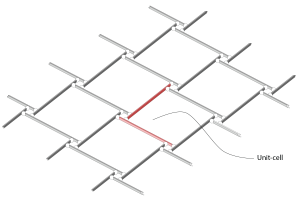
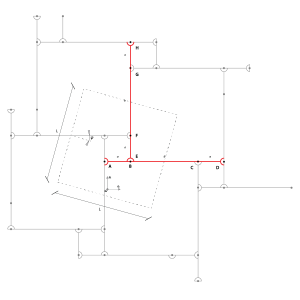
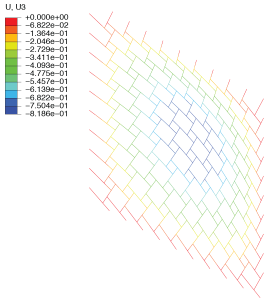
Influence of the pre-stress on the buckling capacity of elastic grid shells – R. Mesnil et al. (2013)
Authors
Mesnil R., Ochsendorf J., Douthe C.
Abstract
The paper presents some results on the influence of the pre-stress induced by the erection method in elastic grid shells on their buckling capacity. The numerical methods have been validated with the study of a pre-buckled arch. A form-finding scheme using low-speed dynamics has been employed to generate automatically a family of elastic grid shells. Their buckling capacity has been compared to the one of grid shells with the exact same geometry, but without any pre-stress. The paper demonstrates that the pre-stress decreases the buckling capacity of elastic grid shells.
Reciprocal systems based on planar elements – O. Baverel and A. Pugnale (2013)
Author
O. Baverel, A. Pugnale
Abstract
This paper deals with the design of reciprocal spatial configurations, based on the use of planar elements, which are investigated and classified according to their morphological characteristics and design potential. Reciprocal structures were first originated as assemblies of elongated elements. In Europe, the concept of spanning longer distances than the length of the available timber beams was the key reason for the use of such structures, which were therefore called ‘short-beams’. In the East and especially in China, the use of interwoven strips of bamboo for the construction of baskets is an old tradition that was transferred to larger scale objects, and which has also led to the development of reciprocal configurations based on linear elements. In this framework, a study of reciprocal systems, based on the use of 2D planar panels, is proposed. A first morphological classification of reciprocal systems based on planar elements, which have been divided according to the shape of the elements and growth possibilities of their assembly, is provided. Moreover, some research issues for future investigations are highlighted. The presented systems and prototypes were developed by students at the École des Ponts in Paris during their Master’s degree and a workshop run by the authors in March 2012.
From shape to shell: a design tool to materialize freeform shapes using gridshell structures – L. du Peloux et al. (2013)
Authors
L. du Peloux, O. Baverel, F. Tayeb, J-F. Caron
Abstract
This paper presents the overall design and construction process of a gridshell in composite materials at Créteil, in Paris suburb. This religious edifice of 350m² is a temporary cathedral meant to gather the parishioners during the two-years renovation of their permanent cathedral. It can accommodate up to 500 people and complies with all the required performances for such a building: structural stiffness, fire safety, waterproofness, lightning, thermal comfort, etc. This project arises thanks to a long-term collaboration between T/E/S/S and NAVIER and marks the accomplishment of a ten-years research project in the area.
Construction of gridshells composed of elastically bended elements and covered by a stretched three-dimensional membrane – F. Tayeb et al. (2013)
Authors
F. Tayeb, O. Baverel, L. du Peloux, J-F. Caron
Abstract
This document deals with the gridshells built by the Navier laboratory in the last ten years. The numerical conception is developed, from the draft made by architects up to the final structure. To design a gridshell several numerical tasks have to be performed. The geometry of the gridshell is first considered. Then, an iterative step mixing geometry and mechanical considerations is important. In particular, it is explained how the naturally straight beams are bended to form the final shape. This active bending provides many interests like high stiffness for a light weight structure. After the numerical design of the grid, the geometry of the membrane is drawn from the numerical final geometry of the gridshell. The improvements of gridshells, including safety considerations as well as practical considerations are then developed, trough the four gridshells recently built.
Experimental study of the influence of matrix system on pultruded GFRP composites’ creep beahviour under flexural loading – S. Barboura et al. (2011)
Authors
S. Barboura, N. Kotelnikova-Weiler, J.-F. Caron, O. Baverel
Abstract
Date
2011
Conference
CDCC2011, The Fourth International Conference on Durability & Sustainability of Fiber-Reinforced Polymer (FRP) Composites for Construction, Quebec City
Links
Long-term behaviour of glass-resin pultruded composites for structural application in construction – S. Barboura et al. (2010)
Authors
S. Barboura, N. Kotelnikova-weiler, J.-F. Caron, O. Baverel
Abstract
Date
2010
Conference
14th European conference on composite materials, Budapest
Links
A concept of a beam prestressed by bending: Application to a footbridge in composite materials – O. Baverel and J.-F. Caron (2009)
Authors
Baverel O., Caron J.-F.
Abstract
This paper proposes a concept of a beam prestressed by bending. An application through an example of footbridge with three supports is shown and illustrated. By bending a beam with a central cable, this cable will be in tension. This cable is then able to act as column which is an advantage as it cannot buckle. In this example, the method of calculation is given and shows that composite materials are well suited for this application. Finally the construction of a scale one model is shown and the authors conclude on the interest of such concept.
Mapping two-way continuous elastic grid on an imposed surface: Application to grid shells – L. Bouhaya et al. (2009)
Authors
L. Bouhaya, O. Baverel, J.-F. Caron
Abstract
This paper presents a method to generate a grid shell on an imposed shape and imposed boundary conditions. The proposed method is done by mapping a two-way continuous elastic grid on an imposed surface using an explicit dynamic finite element method. An initially flat two-way grid, with free boundary conditions, is set up over a fixed surface that has the desired shape. Then, the grid is dropped on the fixed surface. Moreover, different strategies of formfinding are presented and a comparison with other methods is done. Finally, many examples are shown to illustrate the proposed method.
Nexorade: a structure for ‘free form’ architecture – O. Baverel et al. (2006)
Author
O. Baverel, C. Douthe, and J.F. Caron
Abstract
The objective of this paper is to discuss the geometrical properties of different grids used for the creation of nexorades.
Date
2000
Conference
Adaptables 2006, TU/e,
International Conference On Adaptable Building Structures
Eindhoven The Netherlands
Links
PhD Thesis
- All
- Active Bending
- Composite Material
- Gridshell
- Nexorade
Optimisation mécanique et énergétique d’enveloppes en matériaux composites pour les bâtiments – N. Kotelnikova-Weiler (2012)
Author
N. Kotelnikova-Weiler
Abstract
The majority of existing buildings does not follow present energy efficiency regulations. In order to fulfill environmental requirements it seems impossible, in this context, to consider a global demolition-reconstruction policy. Renovation programmes need to be implemented. An innovative energy efficiency improvement solution is proposed, enabling to explore urbain energy ressources presently underexploited. The concept is to add, around the building, an external envelope whose main function would be to collect energy. An optimization tool aiming at finding the optimal geometry and collectors' spatial distribution on the envelope's surface, is developed. Its validation is carried out on simple cases, it is then applied in situations showing strong contrasts: optimization during summer and winter, in Oslo and in Tunis, with close obstacles partially masking the Sun. In order to build the emerging complex geometries, the use of gridshell structures is proposed. These structures are obtained through elastic deformation of an initially plane grid made of composite material slender beams. This raises the problem of composite materials durability under sustained loading. In order to study the long-term behavior (creep and creep rupture) of these materials composed of reinforcing fibres and a polymeric viscoelastic matrix, a micromechanical model is developed. This shear-lag type model allows studying the influence of the constituents' mechanical properties on the lifespan of the composite under permanent pure traction or combined shear and traction loadings.
Optimisation structurelle des gridshells – L. Bouhaya (2010)
Author
L. Bouhaya
Abstract
Gridshells are often defined as structures that have the shape and rigidity of a double curvature shell but they consist of a grid and not a continuous surface. They are obtained by elastic deformation of a two-way grid initially flat. The deformed grid is then rigidified using a third direction of bars. Thus, a gridshell has an interesting structural potential and can respond to complex architectural requirements. Two methods have been used through out history for the form finding of gridshells, the inversion method and the dynamic relaxation method. Both techniques lead to a deformed grid which is a result of calculations. The form obtained is closed to the one proposed by the architect. A numerical tool based on the compass method is developed in this thesis. It allows mapping aTchebychev net on an imposed form and imposed boundary conditions.Another tool based on an explicit dynamic finite element calculationis proposed. The particularity of this technique is to be able to take into account the mechanical properties of the structure and to simulate the gridshell behavior. Applications of both methods on differents forms show the limitations of mapping a Tchebychev net on an imposed form. The compass method has been coupled with geneticalgorithms. The algorithm optimizes the gridshell by minimizing the curvature in bars in order not to break the bars during the construction. It has been implemented and tested on several surfaces.
Etude de structures élancées précontraintes en matériaux composites, application à la conception des gridshells – C. Douthe (2007)
Author
C. Douthe
Abstract
Les matériaux composites sont des matériaux nouveaux qui possèdent une grande déformabilité et une grande raideur. Les structures de bâtiment qui requièrent ces deux propriétés sont peu nombreuses et les gridshells en sont un bon exemple. En effet, ces structures à double courbure sont obtenues par déformation élastique puis rigidification d'une grille plane sans raideur en cisaillement. Les grands déplacements et les grandes rotations qui surviennent durant la phase de montage de ces structures élancées précontraintes nécessitent la prise en compte de non-linéarités géométriques importantes. Un outil numérique spécifique reposant sur la méthode de la relaxation dynamique est donc développé et validé. Il permet une nouvelle approche de la forme des gridshells et la mise au point d'une méthode de recherche de forme originale. Il est également utilisé pour l'étude géométrique et l'analyse structurelle de prototypes de gridshells en matériaux composites construits sur le site de l'École Nationale des Ponts et Chaussées.
Shape control of a Fibre reinforced Polymer Bridge – A.S. Jülich (2006)
Author
A.S. Jülich
Abstract
This work introduces a control strategy to increase the security factors and rigidity of a Fibre Reinforced Polymer Bridge. The double-bow of the bowstring bridge is obtained by an elastic buckling of straight glass fibre pipes. The bows are stabilized with carbon fibre cables and zigzag stays. Crossbars at the intersection of cables and stays support the bridgedeck. The selfstress held in the structure depends on the choice of the pipes. A Finite Element Study highlights the weak points of the structure. The control stategy aims to interactively redistribute the forces within the bridge's tension elements, and to minimise the deck displacement, and is based on equilibrium shapes. Different stress-equalizing geometries can be determined with the Force Density Method. The target shape for a given external load is the stress-equalizing geometry with the minimum deck displacement. A control device adapting the stays force, the bridge becomes a smart structure.
Nexorades: a family of interwoven space structures – O. Baverel (2000)
Author
O. Baverel
Abstract
Master Thesis
- All
- Active Bending
- Gridshell
Stability of elastic grid shells – R. Mesnil (2013)
Author
R. Mesnil
Abstract
The elastic grid shell is a solution that combines double curvature and ease of mounting. This structural system, based on the deformation of an initially at grid without shear stiffness was invented more than fifty years ago. The apparition of new materials such as GFRP increased the potential of such structures whose properties depend on the deformation, or equivalently pre-stress of an initial structure. Elastic grid shells seem particularly promising as shelters, lightweight roofs, or kinetic structures. Although fundamental to the behavior of the strucure, the influence of the pre-stress on the stability of elastic grid shells has yet to be studied. Understanding this phenomenon could allow engineers to design more efficiently elastic grid shells. This thesis studies the influence of pre-stress on the stability of elastic grid shells. The research conducts a parametric study that focuses both a pre-buckled arch and initially at circular elastic grid shells with dierent grid spacing and levels of pre-stress. Realistic values of the parameters are determined from existing projects. The buckling analysis as well as the form-finding of the different structures are performed using finite element analysis. The tools are validated with comparison of the shape and buckling capacity of a pre-buckled arch with existing experiments. The parametric studies lead to recommendations aiming to facilitate the design of elastic grid shells. Keywords Elastic grid shell, Low-Speed Dynamics, form-finding, linear buckling analysis
Our courses at Ecole des Ponts ParisTech and ENS Architecture Grenoble
Find here a selection of courses that we teach in the domain of structural design.
- Conception des structures (Prof. C. Douthe, Ecole des Ponts)
- Conception avancées des structures (Prof. O. Baverel, Ecole des Ponts)
- Construire le courbe (Prof. C. Douthe, Ecole des Ponts)
- Construire une arche (Prof. O. Baverel, Ecole des Ponts)
Recommended Readings
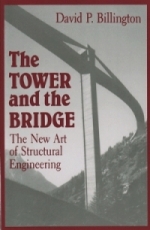
The Tower and the Bridge
David Billington
A classic in the literature on structural design, where the author present the idea of engineering as structural art. This notion is illustrated by the work of masters, like Robert Maillart, Eduardo Torroja, Eugène Freyssinet…
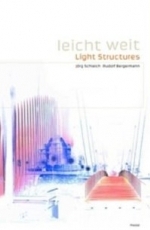
Leicht Weit – light structures
Jörg Schlaich & Rudolf Bergermann
A journey into the work of engineering office Schlaich Bergermann und Partner. The book presents a wide range of projects, form long span bridges to tensile structures or glazed grid shells. The book is illustrated with a large amount of drawings or pictures.
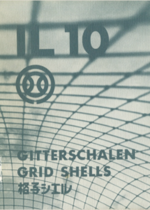
IL10 – Gitterschalen – Grid Shells
Institute for Lightweight Structures (IL), University of Stuttgart
A reference on the design of grid shells, from numerical or physical form finding to applications.
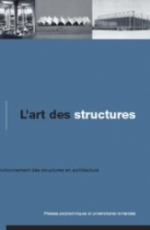
L’Art des structures
Aurelio Muttoni
An overview of structural systems, with an intuitive approach to their functioning. The author illustrates the mechanical concepts with examples of structures by renowned engineers. The book is clear, well-written (in french) and is accessible to undergraduate students in architecture or engineering.
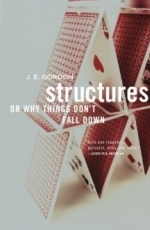
Structures, or why things don’t fall down
James Edward Gordon
This book explores structures with an emphasis on physical principles rather than mathematical developments. The author discusses a variety of applications for the concepts introduced: from the stability of cathedrals to wrinkles in fabric. This book is probably more suited to undergraduate students who need to build their intuition for the understanding of structures.
Shells for Architecture: structural form-finding and optimisation
Sigrid Adriaenssens, Philippe Block, Diederik Veenendaal, Chris Williams
This book explores different aspects of the design of shells and gridshells. It embraces many topics: form-finding, optimisation, classical shell theory. Beautifully edited, it is suited for undergraduate and graduate students.
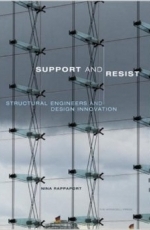
Support and resist – Structural engineers and design innovation
Nina Rappaport
This book illustrates the role of structural engineers in the architectural design process with a focus on fourteen structural engineers.
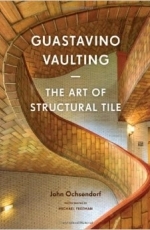
Guastavino Vaulting – The art of structural tile
John Ochsendorf
A monograph on a family of builders that imported catalan vaults in the United States and pushed the limits of masonry structures. It also includes a comprehensive list of Guastavino’s projects and locations. A recommended reading for historians, architects or structural engineers.
Nicolas Esquillan: un ingénieur d’entreprise
Bernard Marrey
Nicolas Esquillan is a master shell builder, who designed the longest spanning concrete shells worldwide. Sadly, he is not as famous as other designers, and this book is a good way to understand his work.
Transparent shells: form, topology, structures
Hans Schober
This book focuses on the glazed gridshells designed by Hans Schober and the team of Schlaich Bergermann und Partner. An important testimony and an interesting read, both for the technical aspects and historical background for steel gridshells.
Costruire correttamente – Savoir construire
Pierre Luigi Nervi
Un amour sans limite
Eugène Freyssinet
An ‘endless love’ for work, materials and invention. The father of pre-stressing explains the birth of his idea and some projects, in different texts gathered in this beautiful book.
The Stone Skeleton: Structural Engineering of Masonry Architecture
Jacques Heyman
The reference to understand the behaviour and design of masonry structures, like arch bridges, Greek temples and medieval Gothic cathedrals, thanks to the clear explanations of Jacques Heyman.
Mémoires d’un ingénieur | An Engineer Imagines
Peter Rice
The mémoires of one of the most innovative structural engineers of the end of the XXth century, on his approach to structural design, his views on construction materials or his collaborations with famous architects like Renzo Piano and Norman Foster on projects like the Sydney Opera and Beaubourg in Paris.
Recommended Websites
Design by Data
The master on computational design and digital fabrication for architecture at l’Ecole des Ponts. We are also part of the teaching team!
D.School Paris-Est
Our coworkers on the campus on the Université Paris-Est at l’Ecole des Ponts. A hub for innovation through design thinking.
Patrimoine Ecole des Ponts
The official portal for the library of l’Ecole des Ponts et Chaussées, the oldest engineering school in the world. Some of the most interesting historical pieces of the biggest library dedicated to construction and civil engineering in France are presented.
Mathcurve
Very useful website with a broad catalogue of surface, fractals, curves, and their properties.
Grasshopper
Forum for the users of the famous graphical algorithm editor. A lot of topics are addressed, that’s definitely the place you want to go if you have scripting problems on Rhino.
Structurae
The largest database for civil and structural engineering. Thousands of built projects are presented, with key informations and pictures.
Shell Buckling
A lot of references on the buckling of shell structures are presented in this website. There are numerous examples of buckled shells in many industries. The website also features a very comprehensive bibliography.
HAL Robotics
Software solutions for collaborative fabrication and design with robots.
XTreeE
A company working on digital processes for architectural manufacturing, and especially 3D-printing with concrete. Some members of the team are involved in the Thinkshell project.
Block Research Group
The website of the Block Research Group of ETH Zurich which focuses on computational design and digital fabrication, with an ongoing collaboration on topology finding.
Space Symmetry Structure
An interesting blog by Daniel Piker, who developed Kangaroo for Grasshopper. He presents some explorations and applications of geometry, mathematics and computation to architectural design.

